Extinction and Ergodic Property of Stochastic SIS Epidemic Model with Nonlinear Incidence Rate
Abstract
We investigate a stochastic SIS model with nonlinear incidence rate. We show that there exists a unique nonnegative solution to the system, and condition for the infectious individuals I(t) to be extinct is given. Moreover, we prove that the system has ergodic property. Finally, computer simulations are carried out to verify our results.
1. Introduction
More attention has been paid to the epidemics models in order to monitor and curb the spread of some human diseases. A classical model is proposed by Kermack and McKendrick in 1927 [1]. They divided the population into three classes denoted by S(t), I(t), and R(t), which expressed the number of susceptible individuals, infective individuals, and removed individuals at time t, respectively. The model is called susceptible-infected-removed (SIR) model, and SIR models were investigated by many researchers [2–4].
- (i)
if (βN/(μ + γ) − σ2N2/2(μ + γ)) < 1 and σ2 ≤ β/N, the disease I(t) will die out with probability one;
- (ii)
if (βN/(μ + γ) − σ2N2/2(μ + γ)) > 1, then model (4) has a unique stationary distribution.
The organization of this paper is as follows. In the next section, we show that there exists a unique positive solution to (7). In Section 3, we carry out a qualitative analysis of the model (7) and extinction conditions for I(t) is derived. We prove that the system has ergodic property under some condition in Section 4. In Section 5, we present some numerical simulations to illustrate our mathematical findings. A brief conclusion is given in Section 6.
Throughout this paper, let (Ω, ℱ, P) be a complete probability space with a filtration {ℱt} t≥0 satisfying the usual conditions (i.e., it is increasing and right continuous while ℱ0 contains all P-null sets) and let B(t) be a scalar Brownian motion defined on the probability space.
2. Existence and Uniqueness of the Global Positive Solution
In order for the model to make sense, we need to show the solution is global and nonnegative. However, theorem of existence and uniqueness (cf. Arnold [15] and Mao [16]) is not satisfied in (7). By using tools established by Mao et al. [17], we will show existence and uniqueness of the global positive solution of (7).
Theorem 1. For any given initial data I(0) = I0 ∈ (0, N), there exists a unique solution I(t)∈(0, N) for all t ≥ 0 with probability 1.
Proof. It is obvious that the coefficients of the SDE (7) are locally continuous. For any given initial data I(0) = I0 ∈ (0, N), there exists a unique maximal local solution I(t) on t ∈ [0, τe), where τe is the explosion time. In order to show that the solution is global, it is sufficient to show τe = ∞ a.s. Let m0 > 0 be sufficiently large so that I0 lies within the interval [1/m0, N − 1/m0]. For each integer m ≥ m0, we define the stopping time
Define a function V : (0, N) → R+ as follows:
3. Extinction
In this section, we will point out the condition for I(t) to be extinct. We firstly do some preparation work.
- (1)
σ2(x) > 0, ∀x ∈ J,
- (2)
∀x ∈ I, ∃ϵ > 0 such that ,
where J = (l, r); −∞ ≤ l < r ≤ ∞.
Lemma 2 (see [18].)Assume that (1) and (2) hold, and let X(t) be a weak solution of (12) in J, with nonrandom initial condition X0 = x ∈ J. Let p be given by
Theorem 3. If , then for any initial data I(0) = I0 ∈ (0, N), the solution of SDE (7) has the following property:
Proof. Applying Lemma 2 with b(x) = β(N − x)x/(1 + αx2)−(μ + γ)x, σ(x) = σ(N − x)x/(1 + αx2) and c ∈ J = (0, N), we can compute
We see that
4. Ergodic Property
In this section, we show that the small perturbation forces the infective individuals to be ergodic.
Theorem 4. If , then, for any initial data I(0) = I0 ∈ (0, N), the solution of SDE (7) is ergodic.
Proof. If , we get
Remark 5. If α = 0, then
5. Simulations
Using the discretized equation and with the help of Matlab software, choosing the appropriate parameters N = 2, β = 0.5, μ = 0.2, γ = 0.3, and α = 0.5, we get simulations of system (7) and the corresponding deterministic system.
In Figure 1, we choose initial values I(0) = 1.8 and 0.4, respectively, σ = 0.6, noting that 2(βN − μ − γ)/σ2N2 = 0.694 < 1, as the case in Theorem 3 expected, for any initial value I0 ∈ (0,2), the large white noise leads to the extinction of I(t) and the solution of system (7) tends to zero; that is, the disease dies out. While the solution of corresponding deterministic system does not tend to zero.
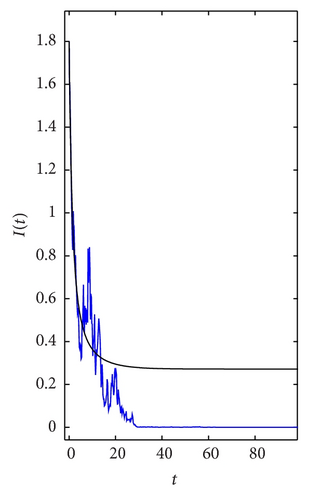
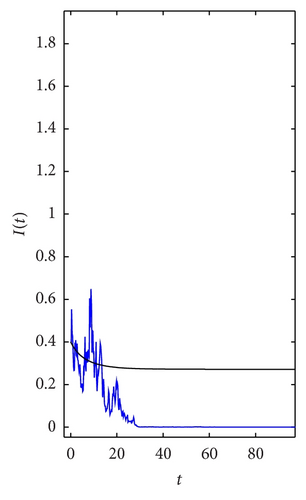
In Figure 2, we choose σ = 0.2 and 0.05, respectively, with initial values I(0) = 1.5, which satisfy the cases in Theorem 4; that is, 2(βN − μ − γ)/σ2N2 > 1. From the left picture in Figure 2, we can see that the solution of system (7) is fluctuating in a small neighborhood, and there is a stationary distribution (see the histogram in Figures 2(b) and 2(d)); the disease becomes endemic.
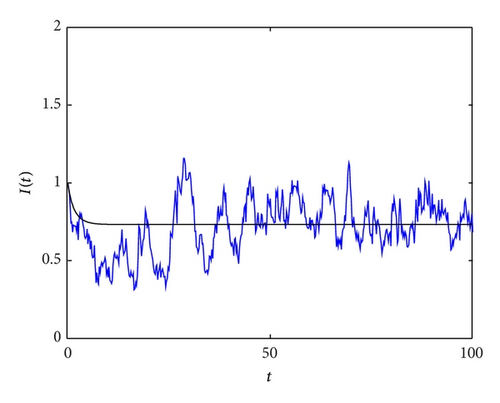

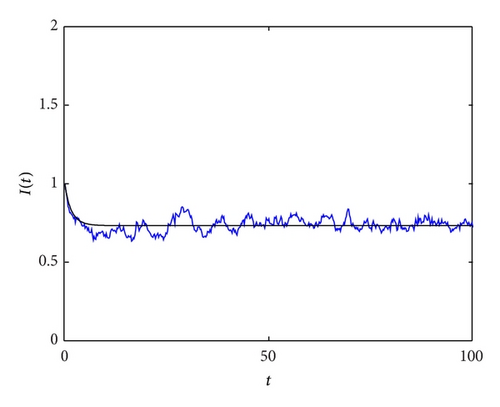
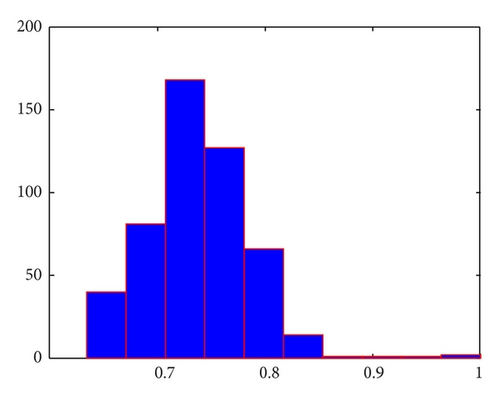
6. Conclusion
In this paper, we analyze the dynamic behaviors of a stochastic SIS model with nonlinear incidence rate, under the assumption that the population lives in an environment subjected to random fluctuations which mainly affect the disease transmission term. First of all, we show that there exists a unique positive solution in system (7). Moreover, we obtain the threshold between prevalence and extinction of the disease; that is, if , the disease will die out with probability one; if , I(t) is ergodic, which means the disease will become endemic. Finally, we illustrate our results with computer simulations.
We see that if α = 0, (7) becomes (4), which is studied in [10]; they show that if βN/(μ + γ) − σ2N2/2(μ + γ) < 1 and σ2 ≤ β/N, the disease I(t) will die out with probability one. Obviously, βN/(μ + γ) − σ2N2/2(μ + γ) < 1 and are equivalent. The condition σ2 ≤ β/N, however, is not necessary in our investigation. In addition, if , the invariant density is obtained, which is not mentioned in [10].
An extension of our work is to consider a stochastic SIS model with the general incidence rate βIpS/(1 + αIq), and it is currently a work in progress.
Acknowledgments
The work was supported by the Program for Changjiang Scholars and Innovative Research Team in University, NSF of China (nos. 11371085 and 11101072); the Ph.D. Programs Foundation of Ministry of China (no. 200918); and the Nature Science Foundation of Changchun Normal University (no. 2010007).




